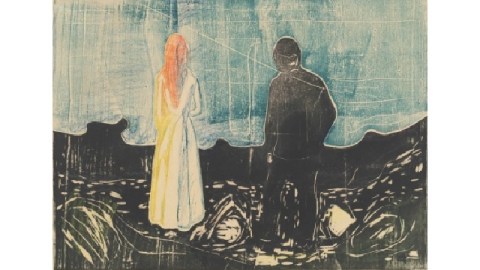Holding On: Edvard Munch’s Prints at the NGA

When you hear the name Edvard Munch, you almost immediately think of The Scream. It’s unavoidable. Even during his lifetime, Munch found himself linked to that image and a select few others from his Frieze of Life series that comprised almost his entire career. Although Munch painted several versions of The Scream, the demand for more overwhelmed the supply. As a solution, Munch turned to printmaking, which allowed fans to have an authentic Munch at an affordable price, while also allowing Munch to capitalize on his fame. But it was much more than pure capitalism that compelled Munch to revisit certain themes and images, as Edvard Munch: Master Prints, now at the National Gallery of Art, Washington, DC, clearly demonstrates. Printmaking allowed Munch to hold on to certain images seemingly forever in a cycle of creation and recreation that made the image and the emotions linked to that image forever new and forever real.
As Andrew Robison remarks in the introduction to the catalogue to the exhibition, “Munch crystallized many of his profound psychological experiences into visually condensed but potent images… [and] [o]nce he gave definitive form to such an image, he could hardly drop it.” Printmaking allowed Munch to tinker with a favorite image again and again, varying colors or other effects to convey different shades of the same emotion. An astute businessman, Munch made the most of printmaking to further his career economically, of course, but that does not take anything away from the artistic aims of his printmaking program. As the exhibition and catalogue explain, Munch sometimes created multiple versions of a print for the sake of variety, but in other cases eventually settled on a favorite setup, which suggests that the variations on that theme were more like stages of the image’s evolution rather than aesthetic caprices.
Munch first encountered printmaking in Germany in 1894. He soon fell under the influence of successful German printmaking artists such as Max Klinger and Joseph Sattler. In her essay, Elizabeth Prelinger traces Munch’s evolution from lithography, which allowed Munch to draw freely on the limestone, to woodcuts using the side grain block, which became en vogue during a revival of interest in the work of German uber-artist Albrecht Durer. Unfortunately, World War I interrupted Munch’s association with Germany on many levels, ranging from physical separation from his printing blocks to an ideological divorce forced by the conflict. “Munch’s rejection of the darker symbolist works [of his German period] in favor of the brighter palette and more decorative forms of Matisse’s art emerged in his graphic art,” Prelinger writes. The Germanic Munch gave way to the French style of Matisse and, thus, created a new Norwegian nationalist style free of unfavorable ideological taint. “Although color remained Munch’s foremost source of visual and emotional communication until the end of his life,” Prelinger concludes, “his accommodations to political, economic, and artistic forces during the war redefined its role.” This exhibition excels at giving the full picture of the forces at work behind the prints both artistically and historically, allowing us to feel everything that Munch may have felt when making them, both in his interior and exterior lives.
Memory plays such a powerful part of Munch’s art, and his prints exemplify that more than any other medium he used. Munch’s “reworking of both his paintings and his graphics embodied a therapeutic process characterized less by repetition than by reiteration,” Prelinger believes. This revisiting of the scene psychically gives a power to each print that simple repetition of a theme could never possess. Of course, some themes become more and more decorative over time—a nod to the influence of Matisse—but that decorative effect seems like a cherishing of a feeling burnished to a brighter shine over time. Other themes pushed Munch to greater creativity to achieve exactly what he wanted to express. In several prints, including The Lonely Ones (shown), Munch cut up the elements of the image like a jigsaw before reassembling them in the final print, a technique some believe he invented, while others credit Gauguin. Nevertheless, each image became a kind of puzzle for Munch to ponder endlessly, as if he continually saw it for the very first time.
“Prints mimic what we are as humans,” Robison quotes Kiki Smith in his essay, “we are all the same and yet every one is different. I think there’s a spiritual power in repetition, a devotional quality, like saying rosaries.” Smith’s metaphor explains Munch’s printmaking beautifully. Munch formulated a personal mythology with each image contributing to a personal odyssey he revisited again and again, like a priest saying the mass each Sunday. Edvard Munch: Master Prints is a chance to enter the church of Munch and hear his gospel in painstaking detail. One visit and you’ll be converted to the power of emotions that perpetuate infinitely through the creative act of a single man.
[Image: Edvard Munch. The Lonely Ones, 1899/c. 1917 or later. Color woodcut, from one woodblock sawn into three pieces, in black, blue green, yellow, and red with hand coloring on medium cream wove paper. The Epstein Family Collection. © Copyright Munch Museum/Munch Ellingsen Group/ARS, NY 2009.]
[Many thanks to the National Gallery of Art, Washington, DC, for providing me with the image above and a review copy of the catalogue to Edvard Munch: Master Prints, which runs through October 31, 2010.]





